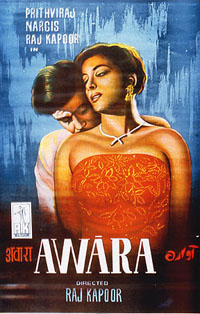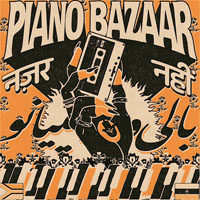
NO NAZAR
PIANO BAZAAR (No Nazar)
No Nazar is an L.A.-based collective label into diverse global sounds. On this outing they have taken four classics of Bollywood and given them "Amapiano" remixes. Amapiano is a sound associated with South African house music. The word Amapiano is Zulu for "the pianos," though the only keyboards here are synths, giving us fat bass lines and strong percussive tracks. I used to watch a lot of Bollywood movies, and still follow composer A. R. Rahman. The 1999 movie Taal, which he scored, gives us the opener "Taal se taal Mila," sung by Alka Yagnik and Udit Narayan. Alka is a lovely singer, though eerily like Asha and her late sister Lata: I guess that is the gold standard in Hindi pop singing. Rahman uses a great backbeat on tablas and stomping ankle-bells and then a solo on fiddle makes a nice rustic counterpoint to the lush strings. The great and prolific Asha is, in fact, the singer on "Rang de," another Rahman composition from the 1999 filmi Thakshak. In India it is a popular wedding song (26 million youtube viewers can't be wrong). Forget "Wednesday's dance," which seems to be everywhere suddenly, check out the moves in the video, with the great Tabu. Wisely, the Ampiano guys kept the flute solo. "Deem to dare," Also from Thakshak, is from the Kathak classical dance tradition. "Kali Nagin" departs furthest from the original, in a tasty remix by DJ Sudi x Mtooray with a song from another 1999 movie, Mann, which again features the eerily high voice of Alka Yagnik. The Ampiano texture adds a lot to these songs making them, perhaps, more palatable for Western dance floors, though Bollywood purists will doubtless decry them.
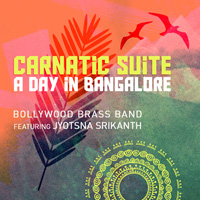
BOLLYWOOD BRASS BAND w JYOTSNA SRIKANTH
CARNATIC SUITE -- A DAY IN BANGALORE (Bandcamp)
The esteemed BBB added a violin to their line-up for their last outing Carnatic Connection, and apparently scored a big hit at WOMAD in UK earlier this year. Their latest disc is a 4-track EP of more fun from the same line-up. As usual they dive right in with high energy. To a driving rhythm on the drums, the bass horns set up a dubby counterpoint and this time the violin leads the melody. The sousaphone bassline has a nice menacing rumble to it. The Indian film music they play has new layers of complexity from years of live performance and BBB have made it truly their own, but on this outing, I think they have written the material themselves. They seem to have trap drums as well as tabla or dhol and even a jew's harp thwonking in the background. The violin blends well with the layered horns, and a sweetening hint of echo brings it into the filmi realm.

BOLLYWOOD BRASS BAND
CARNATIC CONNECTION (BOLL CD2005)
Bollywood Brass are back and firing on all cylinders in their latest foray into the exciting world of Indian film music. This time out they add as guest Jyotsna Srikanth, known as Europe's leading Indian classical violinist -- an exponent of the South Indian or Carnatic style from her native Bangalore. I know many of these tunes from the instantly recognizable "Jai ho" to "Kehta Hai Mehra Dil" (from Jeans), to "Kehna Hi Kya" from Mani Ratnam's blockbuster Bombay (which was made in Tamil then dubbed into Hindi, then also into Telugu). "Kehna Hi Kya" is another A.R. Rahman composition, and one of the stand-out tracks on BBB's debut album, as well as a special "Punjabi" disco mix therein. On this album, the violin makes a good counterpoint to the smooth brass of the trumpet and trombone. The addition of Srikanth's violin to "Kehna hi kya" is a fine touch. I recognize the tune "Rakkamma Kaiya Thattu" but googling doesn't jog my memory. "Rakkamma" comes from a South Indian film called Thalapathi which I don't know, but it looks like fun. A remarkable departure for BBB on this outing is that they have composed new music for a film. Some of the wonderful early Bollywood films have very thin soundtracks on them, despite utilizing full orchestras at the time. Sahra Moore and Kay Charlton of BBB have scored two climatic scenes from the 1948 Chandralekha, and uploaded it to YouTube for your approval. Since Bollywood producers have not commissioned them yet, despite my earnest suggestion, they took the obvious step of showing the world what they are capable of. Maybe the San Francisco Film Festival can bring them to perform. I've seen The Golem with Club Foot Orchestra, Man with a Movie Camera accompanied by Alloy Orchestra, Dengue Fever playing along with The Lost World, and other classics. BBB with this epic would be a great attraction. As ever the dhol drums (the opposite of the doldrums) keep things from going on the nod, and we get some rave-ups in these tunes. The violin adds gold filigree to the finely woven fabric. The album ends, in BBB tradition, with four disco remixes.
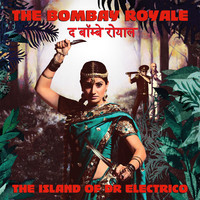
THE BOMBAY ROYALE
THE ISLAND OF DR ELECTRICO (Hope Street)
Another dose of Bollywood-inspired fun from the Bombay Royale for those of you who wore out your Bombay the Hard Way CD. It's intense, wild, electric, and yes you can check it out on their website here, so you can decide for yourself. Come on you loved Slumdog Millionaire, particularly its soundtrack, didn't you? And the best parts of spaghetti westerns and James Bond action films are always the soundtracks too. Starting from the premise that anything goes in Bollywood, from funk to surf to disco to "dil cheez," this group of Australian fans give you a soundtrack to whet your imagination. Beautiful sari-clad maidens lost in the jungle? Right here, calling out to Bobby in the psychedelirious "Wild Stallion Mountain," which also has a Sergio Leone-sounding theme as the outtro. The lead-off single "Henna Henna", also with hints of "Good, Bad and Ugly" horns, and coconut/horseshoe percussion, has a matching video to show you what the band are thinking while playing their music. But it's better to ignore that and let your own imagination loose.
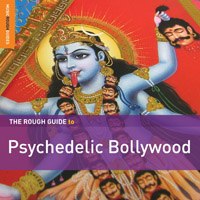
THE ROUGH GUIDE TO PSYCHEDELIC BOLLYWOOD (RGNet 1302CD)
Rough Guide is late to the party, but a welcome guest nonetheless, and because they showed up late, others have brought most of these tracks, which we have been enjoying since Motel Records' blockbuster Bombay the Hard Way took our speakers by storm in 1998. Psychedelic Bollywood, as you know, is the soundtrack to some of the craziest stuff ever put on celluloid. The Hippies brought the sitar back from their pilgrimages and the Indians laughed, saying, you can't teach us anything about mind alteration we didn't invent. From Helen in "Gumnaam" (1965) to Helen in "Dharmatma" (1975), it has to be seen to be believed. Part of the charm is in the familiarity of the music: Western pop riffs from Chubby Checker to Burt Bacharach, from Mason Williams to the Zombies, filtered through a classical sensibility that has sitars and dhol drums instead of guitars and snares. You will recognize many of these tunes, especially if you have any Bollywood albums, like the Nascente 3-disc set, Beginners Guide to Bollywood, which has five of the tracks presented here. Five more of the tracks were on Kalyanji & Anandji's The Bollywood Brothers, a great double disc from Saregama, based on their EMI catalogue. Kishore Kumar was already on Rough Guide's Bollywood Gold comp; in fact most of this will be familiar to you if you are into Bollywood music. Asha Bhosle's "Mera naam hai Shabnam" was on her earlier Rough Guide comp; the other songs from her repertoire, "Yeh mera dil yaar ka diwana," "Naujawan," and especially "Piya tu ab to Aaja," are very familiar. (The latter was on the first Rough Guide to Bollywood.) The bonus Disc is the Rough Guide to R. D. Burman, again containing some very familiar songs, like "Chura Liya," "Ek ladki ko dekha," and "Dum maro dum," but they are indeed Burman's greatest hits. The duplication is not as apparent as on the Psychedelic comp, unless you have the EMI Years comp from Saregama (which has 7, more than half, of the songs on the bonus disc). The bonus may send you to YouTube, to see the incredibly sad ballad from "Aradhana," sung by S.D. Burman, or the hilarious rapscallion Johnny Walker offering scalp massages in "Pyaasa" (one of my favorite films): "Sar jo tera chakaraye" sung by Mohammed Rafi, or the weirdly Spaghetti-westernish "Yeh Shaam Mastani," sung by Kishore Kumar in 1971's "Kati Patang."
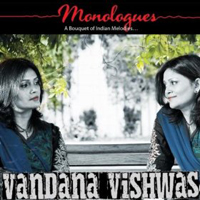
VANDANA VISHWAS
MONOLOGUES (VW002)
Here's another power-shot from Canada: this time it's an Indian singer who, though trained as a classical singer of Hindustani ghazals, has modeled herself after Asha Bhosle and Lata Mangeshkar. Those two sisters are known for voicing most of the big Bollywood hits of the last half century, which were written for them by a wide range of composers from RD Burman (the Godfather) to Shankar/Ehsaan/Loy (the Amar Akbar & Anthony of Filmistan) to Kalyanji and Anandji (aka the Bollywood Brothers). Vandana Vishwas has spent her life absorbing these filmi tunes and certainly could have taken her place up there in the constellation of great playback singers were it not for a childhood accident that crippled her. Instead she became an architect, but now sings playback to her own imaginary movie. The effect is the same intensity you get from watching Rekha or another screen goddess lip-synching in a glittering sari while the full moon shines down on a painted backdrop. I was quite taken aback when I put this CD on: I was not really expecting much beyond a quick listen then precarious placement on the toppling stack of untouchable self-produced discs that come my way. But I was immediately transported to that warm place when you have no cares other than an earnest hope that Shah Rukh Khan is going to get the girl, even though he is completely abject and having a hard time even telling her his feelings, and she is blithely planning her marriage to some worthless heel who has just trounced him. But you know in a serious dance-off Shah Rukh is gonna triumph, maybe the corrupt official will suffer remorse, maybe the orphan beggar will turn out to be the lost heir who suffered amnesia, maybe Love will conquer All! Vishwas has a perfect voice for the high-pitched music; her band includes a couple of synths which have sampled the tones of the entire Bollywood orchestra and a couple of loungey jazzmen who add tepid sax & piano. She has written the music and her husband has written the lyrics, except "Innocent heart" which is a famous poem by Mirza Ghalib, a Persian poet from the Mughal Empire. There's a pretty weak video that goes with the dreamy opening track on YouTube. Sometimes the movies in your head are fine, and this outing demonstrates just that.
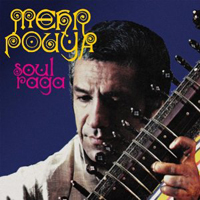
MEHRPOUYA
SOUL RAGA (Pharaway Sounds PHS006CD)
It's obvious Indian music was never restricted to the sub-continent. Any day now I expect someone to rediscover some Kazakh rock band that was performing in Hindi back in the 70s, but meanwhile here is something equally exotic: an album of Bollywood funk compiled from the lost works of an Iranian sitar player, Abbas Mehrpouya. Between 1968 and 1976 the Tehran-based composer released one album and a load of singles. Kitschy at the time, even kitschier now, they are a big cheesy chunk of lounge meets funk. Sitar, flute and organ dominate; the accompaniment is tabla and tambourine. The debonair interior decorator Mehrpouya has been compared to Les Baxter but casts a wide net and reels in an even wider array of instrumental styles, from the 11-minute workout "African Jumbo" -- stampeding Stax horns over disco guitar -- to "Aseman Migeryad Emshab," which starts out with Bach on organ and is answered by sitar and flute, joined by Mehrpouya's throaty baritone with reverb on 11. Then there's a silly "March of the Toreadors" to demonstrate his alloverthemapness. The question is do we need a double disc of this? The answer is up to you as the madness continues on disc two. There's a complete lift from Isaac Hayes Shaft soundtrack, called "Ghabileye Leyli." The second disc crash-lands in a rockabilly raver called "To Bemani va man," that would do credit to Elvis in Harum Scarum.

THE BOMBAY ROYALE
YOU ME BULLETS LOVE (Hope Street 007CDUS)
It's my fervent hope that while Asha and Lata are still alive they will re-record some of their greatest hits, not in new arrangements, but with the original instrumentation so we can really hear them, as opposed to the low-fi quality of much of their work from the 60s and 70s. Now, for something completely different, I have a review of an Indian film soundtrack where I have not seen the film. In fact I doubt there is a film: although it's billed as a soundtrack album, I think it's only a music video. This is an interesting idea: a "Bombay the Hard Way"-style soundtrack written largely by an Australian composer (Andy Williamson), heavy on the references to RD Burman and those 70s guys like Shankar-Jaikishan & Kalyanji/Anandji who sexed up the screen musically while Amitubby, Rishi Kapoor & co were beating each other up in their flares & paisley shirts with big collars. There are at least two bona feedy oldies in here: "Jaan penechan ho," from 1965's Gumnaam, is routed in a blistering 4 minutes and 28 seconds. "Sote sote adhi raat" was in a Horror B-movie, anthologized on the Bollywood Bloodbath CD, and the new version does it credit. Apparently the original singer, Salma Agha, formed a band with her sister Sabina called AGHA and performed ABBA hits in Hindi! While I can't say I am a fan of disco, the "otherness" filter added by its transformation into Hindi filmi dance music makes it really charming. Other tracks definitely sound like they were in some classic films. In fact a bit of poking about on YouTube indicates the Bombay Royale seem to have started out as an RD Burman tribute band, even if sometimes they fail to live up to the originals. But what they have is a crispness and energy abounding, plus some great chops to create a hi-fi thrill-a-minute ride into Bollywood's Golden Age. While I am sure Burman was listening to Herb Alpert (and you can hear that here), I doubt he was into the B-52s, though who knows. But Bombay Royale's rhythm section surely were. I bet they can pack a dancefloor too. This is a lot of fun and, given that many of the old Bollywood soundtracks are in poor condition sonically, it's great to have a full booming complement of guitars, strings and brass when you crank it up. This goes beyond groovy into the realms of fab.
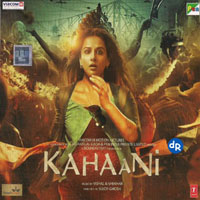
KAHAANI SOUNDTRACK (T-Series)
Kolkatta (Calcutta) is about as far as you can get from Mumbai (Bombay) and still be in the subcontinent, which may explain the strength of this new offering from Sujoy Ghosh. In fact there is no song-&-dance in Kahaani, in the Bollywood sense, the romantic angle is skewed and the action centres around a pregnant woman looking for her missing husband. There is one nod to Bollywood and that is the "Voice of God" -- Amitabh -- who sings the closing song (in Bengali). The film is worth seeing, for the story, the acting, editing, action and locales, more than the music: it's a visual feast and a thriller that keeps you engaged until the dénouement. I will definitely check out the actress --Vidya Balan's -- other films. Gone are the 70s clichés familiar from RD Burman's soundtracks that sound like "Mission Impossible" played by the Three Mustaphas. Bollywood music has lots of new ideas, even if some of them are slightly appropriated from the western pop canon. There are two musical highlights: Sukhwinder Singh doing "Tore bina" (which might be a remake) and Javed Bashir singing "Piya tu kaahe rootha re," complete with heavy metal guitar. Two out of six is not bad, but it's a disappointment that the soundtrack (which is only 28 minutes long) doesn't contain more of the actual soundtrack, i.e. the incidental music, such as the clashing cymbals and drums of the tense finale which takes place during the Durga Puja.
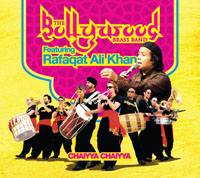
BOLLYWOOD BRASS BAND
FEATURING RAFAQAT ALI KHAN
CHAIYYA CHAIYYA (felmay 8177)
Bollywood Brass has reinvented itself. Diehard fans may not like this, but consider the alternatives: they have delved into the catalogs of the big composers of Indian film music, AR Rahman and RD Burman. They've jammed with Brasilian percussion groups, and they've been remixed, so now they've added a string section and a vocalist. The result is a success. Their brilliant instrumentalists are still evident in the solos and they even recreate some of their greatest arrangements, but the addition of a singer will disappoint some who like their brass polished and sparkling. Rafaqat dominates the first track "Maula Maula," an ancient Sufi hymn, then takes a less prominent role. Though the human voice is no match for an oboe, cornet or clarinet in the right hands, I feel this was a good move. The band will definitely garner new fans and I expect a wider appreciation for their wonderful arrangements. "Chura Liya" returns from their Rahmania album, but now in fuller effect with strings, bullfight trumpet, storming bass and percussion, and blinding solos by the possessed Sahra Moore. Rahman's big hit "Chaiyya Chaiyya" (voted 9th most popular song of all-time by a BBC worldwide poll) returns in a great version (with added train sounds to the outro; I often wondered, watching the video, from the lamentable film Dil Se, if dancers fell off the roof of the train during filming!). Going back to black and white there's the dream sequence from Awaara, one of my favorite films (starring Nargis and Raj Kapoor). I didn't know this is based on an Umm Kalthum hit from the 1930s. However, it sounds very filmi! Moore steps out on soprano on the "Dhoom medley," & "Dum maro dum" returns as an instrumental with some brilliant playing from the leader. "Ain't that peculiar" -- I mean "Gurh nalon iskh mitha"-- comes back too as the closer, with major enhancement from the vocals. The Bollywood Brass Band has gone from strength to strength; the next obvious step would be for some Indian film producer to hire them to write and perform a soundtrack. We live and dream.
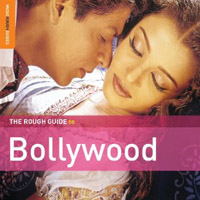
ROUGH GUIDE TO BOLLYWOOD, 2nd edition (World Music Network RGNET1179)
Hollywood invented the movie musical but Bollywood perfected it. Recent American efforts in this field like "Moulin Rouge" were awful (I didn't see "Chicago"), but Mumbai keeps churning out memorable musicals year after year. Even relatively straight films, like the recent ISHQIYA (an action-romance compared to the best of Roberto Rodriguez), manage to work in some great musical moments. The two previous entries in this ROUGH GUIDE category were also called BOLLYWOOD & BOLLYWOOD GOLD. Then there are Rough Guides to top playback singers Lata, Asha and Mohammed Rafi. So what's left? The surprise with this new disc is it is all classic stuff, with not a single A.R. Rahman song in earshot. It's also the twilight of Asha and Lata who are no longer the top recording stars for playback, but what is notable about this compilation (and is seems obvious now) is that it is the first Bollywood comp that is sequenced like a soundtrack, with instrumental breaks interspersed, and not just hit after hit. In fact I think one failing of soundtrack albums is that they leave out the snippets of incidental music that glue the mood together. It starts off with Asha doing "Dum maro dum (Have another toke)" as did the previous Rough Guide to Bollywood, but here we get an instrumental prelude. The flow of the music is really good and this is crucial if you want an album to play over and over. Now Bollywood is an acquired taste, I admit, but it's very easy to get into Bombay the Hard Way -- and you may even notice Mos Def sampled it (as generic "middle eastern" music for a rap about Iraq -- I can't tell you the title, because I deleted it after hearing it once). It also features, in pride of place, one of my all-time favourites: "Ek ladki ko dekha" sung by Kumar Sanu, written by R. D. Burman (the first selection from "1942 a Love story"). Geeta Dutt's "Mera naam Chin Chin Chu" from 1958's "Howrah Bridge," is of course well-known because it was picked up by Mira Nair for her heartbreaking masterpiece "Salaam Bombay!" "Yari Hai Imaan Mera" is from the film "Zanjeer," where it is sung to a lute by the villain Sher Khan (played by Pran), before he has a wild fight with the police inspector played by Amitabh. You can check it out on YouTube. (That's the fight, not the song, which you can look for, if you want to preview it also.) I don't have the liner notes for this CD but there must be some reason for sticking to R.D. Burman's scores from the 70s. "Dilbar dil se pyare" is another fine example, from "Caravan," a very campy number set in a gypsy camp. But "Aaya hoon main tujhko le Jaoonga" is an even campier selection, if that is possible, from "Manoranjan." This one is worth checking out also (It's currently not on YouTube because of copyright violation, but it will be back). You have to see the flamenco dance on the giant guitar. I diverge from critical acclaim on "Mother India," which I thought was sanctimonious and terribly overwrought. But we get "Dukh bhare din beete re bhaiya," sung by an all-star cast. (Despite having my favourite actress -- Nargis -- in it, I just couldn't abide this "classic" which seemed to me like a Soviet propaganda film.) This compilation is complex, the songs chosen have layers of meaning, especially for filmi buffs, and references to other songs. The last song, "Phir milenge chalte chalte" from the movie "Rab ne bana di Jodi," which stars Shahrukh Khan, and the all-babe cast of Kajol, Rani Mukerjee & Preity Zinta, refers to other "Chalte Chalte" songs as well as Raj Kapoor's classic "Awaara," not to mention "Meer jooti hai Japani" from "Shree 420" (as well as "Mississippi Masala"). This album is a fine complement to the Rough Guide to India I reviewed recently. According to the promo literature it is accompanied by a DVD documentary, which I can't wait to see. The only odd thing is the cover pic of Shah Rukh Khan and Ashwariya Rai who were kids when most of this was created, and are associated with a more modern sound: the label missed the chance to use a still from one of the classic films, still that's the disconnect between head and heart. I don't think anyone will be disappointed though.
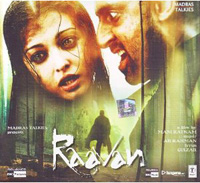
A.R. RAHMAN
RAAVAN SOUNDTRACK (T-Series)
Bollywood went down the toilet faster than Roto-Rooter right after I got interested in it about a decade ago. Still, there's plenty in the DVD store as I find more obscure films by Raj Kapoor, Nargis, Guru Dutt & Johnny Walker to explore. So with no intention of seeing the film (starring Abhishek & Aishwarya -- the Richard Burton & Liz Taylor of Bollywood), I picked up the soundtrack to the new Mani Ratnam movie RAAVAN. It combines the lyrics of Gulzar with the music of Rahman, the most prolific filmi composer in India. Despite the non-stop schedule Rahman still manages to get a hit into each soundtrack & it's been a year since Delhi 6, a very good soundtrack in a rather trite but pleasant enough film. (He scored 11 films in 2010 and has half a dozen in production for next year already.) The game with Rahman used to be spot which Western pop riff he was quoting (though with Vangelis and Michael Jackson as top contenders you really don't want to recall); now it's which Rahman riff is he recycling. It's a unique blend of Hindustani, Carnatic, Qawwali and Western pop and classical modes, but the Duchess begins to suspect it's all "Vande Mataram," a huge hit in 1997 using the lyrics of the Indian national anthem & tugging patriotic heartstrings. Still, his music is rich and draws you in: despite the familiar outlines the detail is varied & he manages to get a compressed intensity from his vocalists so you are caught up in the mood within a few seconds. One thing I don't like about Bollywood is the preachiness, so it's just as well I don't understand the lyrics. But the music has the grand sweep associated with A.R.R. in the use of synthesizers and orchestral strings behind traditional instruments. There's a reedy snake-charmer pipe that sounds like a bagpipe (soloing on "Ranjha Ranjha") & it gets even higher-pitched in "Kata Kata," sounding like nothing on earth. The album is only 29 minutes long (but then it only cost $5) and is just getting off the ground when it ends, which is typical of Bollywood soundtracks.

SHANKAR/ESHAN/LOY
MY NAME IS KHAN Soundtrack (SIN UK)
Shahrukh Khan fell off the radar last year. He didn't even make the top five film idols in India where he has been number one for a decade. He was in the SF Bay Area making a film and with the typical desperation you see in fading stars he appeared on TV advertising a "meet-&-greet" at a hotel in San Jose where, for $150, you could have your photo taken with him or get an autograph. 2009 was a really bad year for Bollywood, not just in the abysmal quality of the films released, but there was a lengthy strike as producers and distributors came to an impasse over what percentage each should get. Bollywood also continues to ape Hollywood so "Benjamin Button" was remade with Amitabh playing a dwarf child-man. And Shahrukh made this film where he plays a man with Aspergers Syndrome who finds himself in a pickle after 9/11. The attack on the World Trade Center was not the first. A decade earlier angry Muslims had blown up a truck of explosives in the basement parking garage, starting a fire. I watched in horror on TV because only a week earlier I had been stuck in that hotel for a snowy weekend & I imagined the panic of the people trying to get out of the smoky hotel down staircases. After the Twin Towers collapsed Dubya called together his cabinet and said, Let's get Saddam! I suspect his mother had said something like, Are you gonna let that sunonabeach diss your father and get away with it? No one, it seems, asked Why would someone do this to us? Osama in his tapes has repeatedly said, We will attack the US until Palestine is safe and free. Now is that such an unreasonable demand? Bushco however are Bible literalists. And there is some rubbish in the Bible about the Jews, Israel & the End Time that they actually believe in. Rumsfeld even put Bible quotations on his interoffice memos. These guys are loonies, but the problem is they have allowed the Israeli lobby to dictate American foreign policy. Ultimately Israel will lose. It's just a matter of time... A Pakistani with a smart bomb in a suitcase in Tel Aviv, or a lumbering scud ridden by Akmad Dinnerjazz. But the US is not helping matters by propping up the failed state of Israel. Let's start by cutting off military aid to them & if that doesn't bring them to their senses, let's give the military aid to Palestine instead. Level the playing field as it were. So given the ongoing state of the Middle East, Osama seems to be exercising the only option he has. There's no question that the USA needs better understanding of the Muslim world. We needs to reach out to Iran, Pakistan and Indonesia in a meaningful way. And before I get off my rant I would like to point out that the Irish Republican Army was reborn in the 1960s during an economic slump in Northern Ireland to murder Brits. As soon as factories were built and employment numbers rose, a truce was signed. Unless America bankrupts itself buying off the Taliban, we will have to put 30 million Yemenis on the welfare rolls too.
This film is about a man named Khan who feels the anti-Muslim backlash after 9/11 and sets off to Washington to have a word with the President. Because he has Aspergers, Shahrukh can play him like an Idiot/Savant (à la Tom Hanks), and there are guaranteed to be wet hankies throughout. If there was an Oscar for Best Male Weeper, Shah Rukh would win hands down. The soundtrack is out now & it is orchestral and lush; the writers have also gone to the Muslim faith and turned out some tunes that would credit Nusrat himself. Well, that may be overstating it, they use the traditional instruments, harmonium and tabla, & the vocalist manages a few warbling scales that certainly evoke Sufi praise singing ("Allah ki Raham"). Shankar/Eshan/Loy have reused a couple of their old hits to pad it out: there's Kuch Kuch Hota Hai from Shah Rukh's 1998 hit film of that name, and "Suraj Hua Madham" from Kabhi Khushi Kabhi Gham, not to mention Kal Ho Naa Ho from the enjoyable film of that name. No doubt in the movie these are references to scenes in the older films in which Shah Rukh also starred -- in one case with the same leading lady. This is a clever ploy because it turns into a "Greatest Hits" sampler and ends upbeat. After bombing out on Kambakh Ishq, I am not rushing out to see this, but instead waiting for the next big historical costume drama from India. However, the soundtrack is very enjoyable. Call it "Bollywood Easy Listening" if you must, but it beats what passes for popular music in the US right now.
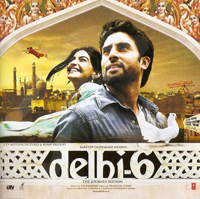
A. R. RAHMAN
DELHI-6 SOUNDTRACK (T Series)
Rahman finally made it to Hollywood, singing at the Academy Awards and taking home two Oscars (the first on that continent since Satyajit Ray's deathbed acceptance, I believe), though this was something A.R. tossed off in a month, and not his best work by any means. I thought after SLUMDOG SQUAREPANTS I would check out some more of Rahman's recent work, so I got this album, without seeing the film. (Recently the Duchess & I saw CHANDNI CHOWK TO CHINA which started badly, got better, then hit the snooze button. It was the first Chinese Martial Arts/Bollywood hybrid and quoted from a lot of films, but overall it was like a huge tub of popcorn without butter.) Thanks to SLUMPDOG the rest of the world is catching up to Bollywood, but the Mumbai film industry is in a notable slump now too. Films are raunchier, more derivative, more into flash and bang than they were a decade ago. The good news about Delhi-6 is it is enjoyable as a suite of music. Javed Ali (who sang the blindingly great Sufi song in JODHAA AKHBAR) is here with "Arziyan," a pleasant reprise of that sound with plangent, liquid tablas and synths doubling the harmonium into the empyrean as bass and the exotic western-tuning acoustic guitar join in. This song, about doves I think, lulls you into soporific bliss, but then is brusquely overtaken by "Dilli-6" which is not a pun on the film's title, but rather the original title which the producers decided was bad numerologically speaking (remember this is India and the producer is not called Ronnie Screwwallah for nothing). It's a pop number with female vocals on a "telephone" mike, chiming keyboards, moog growls and rapping in French. Nuff said. Then the composer himself sings "Rehna Tu," a pleasant love song with typical Rahmanesque touches. These include late 70s Gap-band type funk, I realised. "Hey Kaala Bandar" is like part two of another recent Rahman song. I'm trying to remember which one. It's a song about monkeys. What's more amazing is I suddenly remembered "Bandar log" means "monkey people", something I got from Rudyard Kipling when I was 6 or 7 in the middle of the last century. I read an on-line poll of the most irritating songs ever, and agreed that "The Name Game," should be high on the list. However I remembered Stacy Lattisaw's version, "Attack of the name game", when I was listening to the Banda rap. I guess it's the funny vocal effects, but I don't have bad memories of that Stacy Lattisaw album at all. But it could just be that in listening to Indian music you have to abandon your standards of musical taste since anything goes, apparently, when Rahman is working. There's another quasi-devotional number, "Bhor Bhaye," that is to say it seems like ersatz religious music, by the auspiciously named Ustad Bade Ghulam Ali Khan, along with Shreya Ghoshal. It segues into a genuine religious praise song "Aarti." And if you thought Charlton Heston was God, wait 'til you hear Amitubby Himself with extra bassy voice on the final track, "Noor."
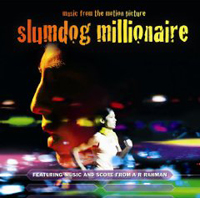
A R RAHMAN
SLUMDOG MILLIONAIRE SOUNDTRACK (Interscope Records/A&M)
The only films being made in the USA any more are cartoons, literally & figuratively. Now that Spielberg has decided to pack his trunk for Mumbai we can expect to see Bollywood quickly eclipse its American counterpart, at least in the effects department. Last year we had The Darjeeling Limited, which was total dreck from beginning to end. There were good moments in the soundtrack but the Americans were such a sorry bunch and their shtick so lame that I found it a complete waste of time. Now a talented director, Danny Boyle, with a good screenplay (from Q & A: a melodramatic novel by Vikas Swarup), has gone to India and shown the world how to make an Indian movie. Boyle used to direct plays at the Royal Court Theatre before turning to film and demonstrates how celluloid is the most important artform of our era. But this is not news. Back in 1936 the famous art historian Erwin Panofsky gave a lecture at the Met in New York claiming that film was a legitimate art form. (Does anyone even go to art museums any more, other than to be pissed off by Jeff Koons or Damien Hirst?) The "Colonized by wankers" speech in Trainspotting is one of my favourite moments in film and I was hoping for equal effervescence from Slumdog. (Jamal's ad-libbed tour-guide patter at the Taj Mahal is priceless.) There is a cloacal reference to Trainspotting which provides an early moment of revulsion and hilarity. The cast is anchored by three Bollywood names: Irfan Khan, who can really act, and has appeared in Mira Nair's films, as well as, recently, Aaja Nachle, and a brilliant turn in Maqbool; Anil Kapoor is an interesting choice to play the host of the TV game show, "Who wants to be a Millionaire?" supposedly a rich bastard with an ego to match. In some respects Kapoor's career is in decline. He was a big leading man in the 80s & 90s until Shah Rukh Khan got those parts he was suited for. The actual host was Amitabh Bachchan, who is a minor deity in India. Amitabh appears as a character in the story (though not seen on camera), but the rest of the cast are unknowns. Although the plot is dickensian and quite ludicrous, the story is well told (Dickens is the major inspiration for Bollywood), the camerawork and editing superlative. Rahman survived Andrew Lloydsbank Webber and has once again been tapped by the West to add the icing to the proverbial laddoo. Jodhaa Akhbar, released earlier this year, was brilliant, but I sense he is overextended. The soundtrack to Yuvvraaj failed to move me, even though he summoned Beethoven to his assistance. (You can always tell a Rahman tune because he has so many signature licks, many of them lifted from Paul MacCartney or Michael Jackson, former Kings of Pap.) Here he had two months to conceive and two weeks to write the score! So he leaned a little on his heritage. There are two reworked filmi hits & a few collaborations. The classic "Choli ke peeche" from Khal Nayak comes back as "Ringa ringa" sung by Alka Yagnik, who manages to sound a lot like Lata on this one. It's great. (You will find a link to the original on YouTube at the top of my Bollywood Video page.) "Aaj ki raat," composed by Shankar-Ehsaan-Loy, a disco inferno complete with stuttering vocoder, is also reworked. (Not to be confused with the Asha song picturised by Helen!) There is a guest shot from a Brit called M.I.A.-- some techno-trash that has a cheeky charm (like Althea and Donna in their day) -- but having stupid lyrics in English spoils the mystique of Bollywood (& it is happening increasingly). This song was brought to the project by the director, but Rahman also collaborated with the artist, M.I.A., on another version of the tune. There's also a "Gangsta Blues" featuring someone called BlaaZe or is that Blah Zee? It sounds like an ad for cel phones, and probably soon will be. But there's another stalwart saved for the finale: Sukhvinder Singh sings "Jai ho," which sounds like Tally ho! Since there is virtually no dancing in the whole film they end with an ensemble performance on the busy platform at Mumbai central train station. Pure joy! Just as Trainspotting had a spot-on soundtrack with Iggy Pop, Ian Curtis and Gorgeous George Bizet hitting you in the solar plexus, Rahman's mandate was to provide half a dozen strong themes in response to the action, and he delivers a six-wicket innings with a few byes. This is a brilliant film and all the elements, including the music, make it happen.

KALYANJI AND ANANDJI
THE BOLLYWOOD BROTHERS (Saregama CDNF 138096-7)
Maybe it's an acquired taste, but I am really hooked on the music of these two guys. Most of us in the West were oblivious to Bollywood films during the golden age and so can only sigh over Rehka or chuckle at Helen in retrospect. Before I went to India I had begun to get into their popular cinema & certainly a big boost was the appearance of two discs in 1998: Bombay the Hard Way & Electric Vindaloo that showcased the work of these talented composers (Dan the Automator added beats and sampled some dialogue from the films to string it together). Kalyanji and Anandij, the Shah brothers, worked from the 1950s right through the '80s, but the '70s was a special time in Bollywood. They got into American gangster movies, James Bond spy thrillers and spaghetti westerns, but more importantly they began to mimic the funk music of Isaac Hayes (the theme from "Rafoo Chakkar," included here, is a straight lift), the orchestral miasmas of Lalo Schifrin, and anything else that seemed remotely hip at the time. The soundtrack to this "Brownsploitation" era was was filtered through their own musical sensibilities so you have a hybrid of a huge orchestra with Carl Stalling marimba breaks, Venetian mandolin, or Herb Alpert trumpet grafted onto what sounds like Gujarati folksongs. Some of it is goofy; some quite enchanting. These modest brothers -- like Stalling -- were workmen first and foremost, striving to provide the right musical ambiance for a film and never seemed to notice that their music was massively successful. There is a little overlap with Bombay the Hard Way (where the music was used without credit), but here is the untreated sound and the cabaret number with evil cackling leaps out at you. Lata, Asha, Kishore Kumar and Mohd. Rafi are the main vocalists. Of course the music makes you want to see the films. Disc one ends with a culture clash: at a puppet show an Anglophile girl in miniskirt with a cigarette and a glass of whisky is singing "Twinkle twinkle little star" and other nursery rhymes while the Desi hero mocks her. I found it on YouTube, but be warned it is rather irritating. There are better songs from that movie, Purab aur Pachhim, here and here. The second disk strays into more traditional territory, though there's still those big orchestral gestures. "Dum dum diga diga" sounds a lot like Shankar Jaikishan who composed many of the hits of the '50s, and indeed it was a pastiche demanded by the combination of actor Raj Kapoor and singer Mukesh who usually sang his part. Everyone expected it to sound like a Shankar Jaikishan number so the Shah brothers gave it to them. "Yeh time time ki baat hai" is a brilliant novelty number (cabaret with xylophone) with a spoken intro in English (Asha Bhosle & chorus) that is a hoot. if I were more technically adept, I'd make a little MP3 of it to amuse myself. A well-sequenced and memorable pair of discs to help you in your filmic pursuits.
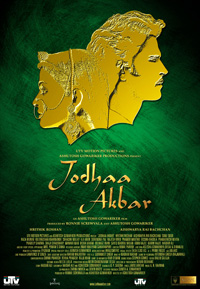
A. R. RAHMAN
JODHAA AKBAR soundtrack (UTV pictures B0012S22VE)
Considering how prolific A.R. Rahman is, this is high quality work. There are memorable moments in this 4-hour history epic that the soundtrack album brings to mind. Sadly, though, the album contains only the five main songs with two instrumental (karaoke?) versions, none of the incidental music & none of the delightful Rajasthani folk tunes that are interspersed at weddings and festivals in the story. Everyone expects a superhuman performance from Ashwariya Rai Bachchan, as from Rahman, and she does an OK job, but the impression you come away with is of spectacular palaces, gorgeous costumes (jewelry by Tanishq), and clashing armies in Cecil B. DeMille-style encounters involving comical canonades and armoured elephants. There is also a clear line to the Busby Berkeley heyday of the 1940s, except it's in glorious technicolour and sung in Hindi. The story is about Akbar the Mughal ruler who married a Hindu princess to pacify the kingdom of Hindustan. In reality he married many Rajput princesses, also Muslim and Christian wives, but that's not part of this story which is served hot with Shakespearean plot twists. Akbar, the genius theologian, writer and inventor, is presented as an illiterate muscle boy. Rahman provides several religious tunes, equally balanced between Hindu and Musulman. There's a hint of Blue Nile (remember them?) on "Inn Lamhon ke daaman mein"; "Mann Mohanaa" (which must translate as "My sweet Lord"), sung by Bela Shende, is very evocative of DEVDAS which Rahman did not write, but which set the standard for costume epics. The highlight is the whirling dervishes in "Marge Simpson" hats who provide a Sufi hymn, sung by the composer, praising "Khwaja mere Khwaja."

MADHURI DIXIT
AAJA NACHLE (Yash Raj Records & Films)
Madhuri Dixit is the Queen of Bollywood and neither the Duchess nor myself will brook any argument on this matter. Why then did her comeback film fail to impress Indian audiences as it should? The Indian critics panned the film so the audiences snubbed it. It was even banned on opening day for a supposed slur on the Dalit caste, but the offending lyric was removed from the title song (Can someone explain to me how hundreds of copies of the film were "fixed" simultaneously overnight?) but it hit the top ten in the UK and Canada and is still showing in the US. The premise of the film is weak, admittedly, but that's never stopped Bollywood before (& it was a lot better than Darjeeling Limited, a petrified pile of camel dung). Basically the Indians were pissed at their top screen goddess for quitting at her peak. Devdas came out in 2001 & was phenomenal, pushing Madhuri, Ashwariya Rai and Shah Rukh Khan (along with veteran Jackie Shroff) into the international spotlight. But Madhuri decided it was time for a break. She got married and moved to the USA to have a family, in anonymity, with her doctor husband. The film uses her "retirement" as a bit of plot. Instead of 6 years she has been gone 12 and they posit that she married Steve McCurry, or someone very like him (a National Geographic photographer) but it didn't work out. (That part was to appeal to all the guys who pined for her and whose dream was shattered when she married someone else.) The film starts in New York with Madhuri working out in her dance studio, looking more shapely than anyone should after having two kids. Michael Jackson is the inspiration for "Dance with me," the opening number, though it sounds suspiciously like Vicky Sue Robinson's "Turn the beat around" -- a forgettable moment of the disco era. Not an auspicious start, but the phone rings ("It must be important, I can't understand a word," says her assistant) and she learns her old teacher is dying and his dance studio is to be torn down by developers, so she flies home to try to save the Ajanta. Of course everyone still hates her for running off with the American but she persuades the local politicos to give her a chance: if she can put on a show --with local talent-- that succeeds, will they spare the theatre? It's corny as hell and very predictable as she collects various talentless misfits, but we are only here for the song and dance numbers. The film builds to a great climax: the staging of the Legend of Laila and Majnu (which has been filmed a dozen times) is magically realised. Music is by the Merchant brothers, Salim & Sulaiman, and is occasionally reminiscent of Devdas in its grand sweep. There's bits of bellydance music, even a hint of "Riverdance"! Rehat Fateh Ali Khan sings the weeper "O re piya," one of the big hits from the film, but "Show me your Jalwa" (whatever a "Jalwa" is, I believe it translates as "joie de vivre") is the other stand-out track, next to the title song. Madhuri is dazzling: she does her little facial gestures at the camera and dances up a dream. You can hear the entire album on-line at filmicafe, but you really have to see Madhuri dance.
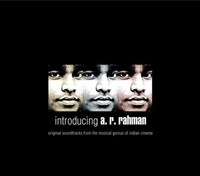
INTRODUCING A.R. RAHMAN
ORIGINAL SOUNDTRACKS FROM THE MUSICAL GENIUS OF INDIAN CINEMA (Saregama CDNF 158788-8)
Here is a compilation that includes some of the less well-known music Rahman has written in addition to a few scattered hits. The first disc opens majestically with a sonorous orchestral piece that reminds one of Arabic-Andalusian music. But it is no pastiche, it is a well-developed mood setter that also borrows from Thomas Tallis and the English chamber tradition. Rahman, crassly known as the "Mozart of Madras," may be a thieving magpie but he knows where to fly. He uses a cumbia-bass line for "Raisika," one of the great songs I don't mind hearing again when it pops in like an old pal halfway though the first side. It was in the 2000 film STAR. My gut-feeling is that he got this, not from a Colombian source, but from Paul MacCartney's bass line on "Obla-di Obla-da." BOMBAY & JEANS, two other blockbuster Rahman soundtracks, are heavily represented, but there is enough unusual and intriguing stuff to make this a worthwhile set. Another favourite, "Yaro Yarodi," crops up next. It's not all adapted from Western influences: there's a lot of his own South Indian musical luggage aboard, hints of Karnatic as well as Sufi music. Virtuoso tabla and other Indian musical instruments are foregrounded with the strings and synths only used as glue. There is some beautiful singing, if you like those ethereal women's voices. Another bona fide hit, "Swasamae," comes on. I haven't seen all these films but the songs are the soundtrack to many pleasant afternoons lolling with the Duchess.
The film industry in India is Mumbai-based, which produces films primarily in Hindi, but there are other film centres and much of Rahman's work is in the minority Tamil industry. His tunes are quickly adapted to Bollywood remakes, but this collection features the original songs as first heard in Tamil-language films. As such it is essential for fans of Rahman and a great introduction to this young genius.
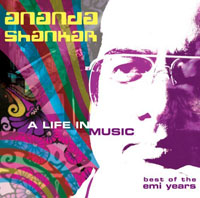
ANANDA SHANKAR
A LIFE IN MUSIC (Best of the EMI Years) (Times Square TSQCD9052)
I used to think life was an Italian movie & I was quim-quaffing Snaporaz. Then I discovered Guru Dutt, Raj Kapoor and Bimal Roy and the soundtrack to my life changed. Ravi Shankar always bemoaned the fact that the sitar was seen as an exotic instrument in the West and used to add hippie flavour to party scenes in 60s films. He also objected to the way the sound was distorted to sound more like a guitar. For him music is spiritual and part of a classical tradition and turning the sitar to pop is an abomination. But the blame can be laid at the feet of his nephew Ananda Shankar (1942-99), who taught Jimi Hendrix, among others, how to twang their sitars. Ananda lived with his uncle in LA and experienced Haight-Ashbury in the 60s, so he is truly patient zero in the "sitars on acid" epidemic that stretched from the Byrds to Brian Jones. Back in Calcutta Ananda started composing and recording. One feature of his music is the way the sessions ran: there were only two mikes in the studio so the soloists would line up and move forward to play before dropping back to let the next soloist in. It was all done live without overdubs. If you are hip to the classic BOMBAY THE HARD WAY and ELECTRIC VINDALOO sets, you will undoubtedly want this. The influence of funk is pervasive but so is the truly Indian sound of wailing Moog synthesizers and funky percussion breaks, women's chorus and skittish flute. There are of course other classical Indian instruments, the sarod, veena and mridangam, being abused here, but they are just part of the wild electronic stew. Ananda Shankar was rediscovered by the younger generation of Indian DJs like Talvin Singh and toured the UK in 1998, even recording some cuts at Peter Gabriel's RealWorld studios. Meanwhile interest in his early work continued to grow (sampled for cell phone ads), with a copy of his earliest album ANANDA SHANKAR AND HIS MUSIC reportedly selling for $1000 to a Japanese collector. Now Alan James (DJ & musical head of the British Arts Council) has found the original EMI tapes for seven of Shankar's albums and put together this glittering showcase.
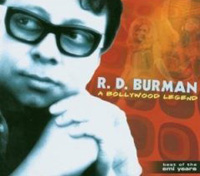
R.D. BURMAN
A BOLLYWOOD LEGEND (Best of EMI Years) (Saregama CDNF 138064-5)
Rahul Dev Burman's legend grows apace. He was the son of S.D. Burman another famous filmi composer, and scored countless hits that were lip-synched by all the leading actors and actresses of his era. But that era was curtailed. A bit of a musical magpie, he was decried for using so many Western influences (from Burt Bacharach to the Dave Clark Five to the Fifth Dimension!) and fell from favour in Bollywood. So after being sought-after in the 60s and 70s, little was heard from him for over a decade until the very end of his career when he scored 1942: A Love Story, and, though he died before the film's release, it swept the Indian music awards and left us "Ek Ladkhi ko dekha (I saw a girl)", arguably the greatest Indian love song of our time. This two-disc set is a treat, it could easily be called The Offbeat Side of R.D. Burman. It contains his more experimental stuff as well as big hits. Missing is "Mehbooba Mehbooba" from SHOLAY, but that has been anthologized plenty. The first disc covers familiar ground. Three-quarters of it has his wife Asha Bhosle singing; the other quarter is alloted to Mohammed Rafi. "Dum maro dum (Have another toke)," camp now but controversial in 1971, is his most identifiable song. "Mere naam hai Shabnam" from KATI PATANG has Asha speaking her lines instead of singing. The voluptuous Anglo-Burmese vamp Helen mouthed the words to "Aaj ki raat aane ko hai (Someone is coming tonight)" in ANAMIKA and this is an unforgettable sexy ditty. Another Helen gem "Piya tuu ab to aaja (Come to me at long last my love)" is included. Both of these and many others, including the magisterial "Chura liya (you've stolen my heart)," from this first disc were included on the Kronos Quartet's collaboration with Asha, so here's your chance to compare the originals. Asha's vocal talents are augmented by the spare arrangement of the haunting "Mera kuchh samaan" from IJAAZAT (1987). She also shines on "Rishte bante hain," one of the few songs not from a film soundtrack. The surprise is the inclusion of "Sar jo tera chakraaye (If your head should spin)," a novelty burlesque calypso, performed by Johnny Walker in PYAASA (1957). The score is credited to dad, S.D. Burman, but apparently R.D. contributed this song. This is perhaps my favourite Hindi film of all (at least among those NOT starring Nargis). The pencil-moustachioed, fez-sporting, unkempt Walker, who elicits chuckles the minute he appears on screen, plays an itinerant scalp-massager in love with a chubby prostitute. The sound is particularly poor on this track but its inclusion broadens our understanding of Burman's talent. Otherwise Rafi gets shorted on this disc. But the over-the-top "Chand mera dil" is here, with an arrangement that leaves you wondering what is in store next? Tijuana Brass trumpets, Barry Melton organ, or Jimmy Page jumbo guitar?
The second disc is the less-familiar stuff, but it is equally as good, drawn from the vast repertoire of 1800 songs Burman wrote. The singers are Kishore Kumar, Lata Mangeshkar and others. Asha was a little peeved when Burman would choose her sister, Lata, for certain songs, because he wanted her more ethereal voice. And, no doubt, this caused marital strife when Lata scored bigger hits. Lionel Bart & Larry Adler are evoked in the opener where Burman himself plays harmonica. Then a blatant rip-off of Chubby Checker's "Twist" is delivered by Manna Dey from the "fun-filled yet scary" movie BHOOT BUNGLA.
The public ate it up, but producers objected to the decadent Western imagery, gogo dancers and night-clubbing smoothies evoked in Burman's songs. Today he would be in great demand as in fact his songs are often sampled by club remixers, and there are the tributes from Kronos Quartet and Bollywood Brass Band. This retrospective includes examples of his ersatz classical music: "Meethey bol boley" -- a Raag Bhairavi dance-exercise song with, at first, only tabla and ankle bracelets accompanying the vocal exercises of Bhupinder. It's based on a Bengali folk song. If you want to experience Burman's music in situ, try renting TEESRI MANZIL, YAADON KI BAARAAT or SHOLAY. Otherwise you should get this very satisfying album and enjoy some of the most creative & catchy pop music you missed the first time around.
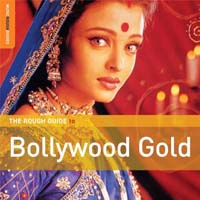
ROUGH GUIDE TO BOLLYWOOD GOLD (RGNET 1182 CD)
One of the biggest obstacles posed by Bollywood music is not the intrinsic "foreignness" or even the Hindi vocals, it's the appallingly bad sound. Many of the hits were mixed down to mono for inclusion on a soundtrack and then recaptured on second-generation tapes or even dubbed off the film for release. So much of the classic movie music from India is doomed to always sound wretched. Recently Asha Bhosle has re-recorded many of her past hits but even with clear instrumentation her voice is not what it was, and so the only hope is to find the albums that were often issued simultaneously with the films. This disc samples some of the musical hits from films of the 60s through 80s. The good thing is it's not laden with the same tracks you find on every other Bollywood gold compilation, in fact there's a lot to be discovered here. Lata, Asha and Mohammed Rafi have all had Rough Guides, done by the same compiler, DJ Ritu, so here they are used sparingly and we also get to hear Kishore Kumar, Mukesh and other lesser-known talents. Mukesh, despite his obscurity in the west, was known as "the man with the golden voice" and sang for Raj Kapoor, one of the three great Indian directors of the fifties, with Bimal Roy & Guru Dutt. AWAARA (1951) is a classic, for it not only stars Raj Kapoor as a Chaplinesque tramp in a too-small suit, but the lovely Nargis [sigh!] plays the female lawyer who defends him and appears in a sublime dream sequence. Among the hits from this film, "Awaara hoon" is included here, but you have to see this one. After MEERA NAAM JOKER bombed, Raj put his teenaged son Rishi in BOBBY (1973) & paired him with Dimple (who looks like a younger Nargis) for this Carnaby-street fashionista version of Romeo & Juliet (with a happy ending). The accordion and strings setting by Laxmikant Pyarelal swirls around the eerily high voice of Lata and the more grounded Shailendra Singh in the lovely duet "Chabi kho jaye."
R.D. Burman's "Yem sham mastani" delivered by Kishore Kumar opens with whistling and immediately evokes the spaghetti western soundtracks of Ennio Morricone. Mukesh returns, singing for Raj Kapoor again, in "Kehta hai joker" from MEERA NAAM JOKER (which, despite its cult status, is not one of my favourites, but then I couldn't stomach MOTHER INDIA either). But SHOLAY (1975) is another must-see Indian film, often called a "Curry Western" because of its similarity to the Clint Eastwood trilogy and films like The Magnificent Seven. It's a simple revenge tale starring Amitabh Bachchan & Dharmendra and has a memorable bad guy, Ghabar Singh. Helen performs a wild gypsy dance, "Mehbooba Mehbooba," in the enemy camp which has been anthologised many times, but here it's presented in a rare live take, sung by R.D. Burman himself, voicing the baddie. It rocks!
In contrast there's a lovely ersatz classical ghazal, "In aankhon ki masti (Intoxicating eyes)" sung by Mrs Burman (Asha) from the original UMRAO JAAN, another of my favourite films. (This was remade last year with Ashwariya Rai in the lead but I doubt it could live up to the original. However Ashwariya's appeal is such that her image from DEVDAS is used on the cover of this CD booklet, though the film is later than the period covered.)
From the camp classic TEESRI MANZIL (Third Floor) we get the big production number "Aaja aaja main hoon pyar tera" in which Helen struts her stuff in a typically over-elaborated set. Taken from KABHI KABHIE, "Tere chehre se nazar nahin" is a classic love duet, this time between Kishore Kumar and Lata. JUNGLEE is another complicated romance, set in the snowy mountains, with an wimpy Elvis-lookalike hero (Shammi Kapoor) who yells "Yahoo!" a lot, but Mohammed Rafi showed he could belt it out, successfully updating his more sombre sound of the fifties in this colour extravaganza.
If there's one film clip I have nearly worn out it's the "Chalte Chalte" dance scene from PAKEEZAH (1971). I even requested Bollywood Brass Band to cover it. It's sublimely erotic and just hearing it has me tingling. Lata sings the part of the courtesan (Meena Kumari) who dances so languidly you know you'll give her all your money just to sit in her presence! Sadly the recording is overmodulated and a bit shrill, but that train whistle at the end slays me. Fortunately we don't leave it there, as there's the return of Kishore Kumar singing "Mere sapno ki rana" from ARADHANA (1969), a convoluted tale of a woman who falls in love with an air force pilot and bears his child as he is killed fighting for his country. She gives up the son, then becomes the nanny to the family who adopted him and he protects her by killing a would-be rapist. Well, it's a typical Bollywood plot and too complex (& Oedipal) to relate in detail but certainly better worth your evening's distraction than any Tom Cruise or Nicole Kidman outing. This compilation is a tasty sampler of some of the great flavours of Hindi playback hits of the golden era.
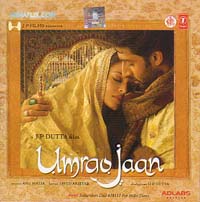
UMRAO JAAN SOUNDTRACK (T SERIES SFCD 1/1161)
2006 was an appalling year for Bollywood: almost all the hits were remakes, and from the North American model we know to what dire depths that leads. Bollywood actors lip-synch to their songs, it's obvious, but I can't help thinking of their faces when I hear the music. I saw Sukhwinder Singh at the Bollywood Music Awards on an Asian Variety Show on TV (live from the Taj Mahal in Atlantic City -- surely Trump knows better than to name a hotel after a mausoleum?). Anyway, Sukhwinder is a great singer but looked like Wayne Newton up there in his embroidered lounge suit. Fortunately they cut to Shah Rukh Khan on video for his big numbers. Alka Yagnik [below left] is India's leading young woman singer, already taking over from Lata and Asha, and when I hear her I think of Aishwarya Rai [centre] and her limpid grey saucer eyes. Aishwarya suffers from "Liz Taylor syndrome": she is lovely to look at but cannot act, and so I wasn't ready to sit through the three hours plus of her remake of one of my favourite Indian films: UMRAO JAAN (1981).
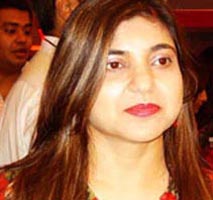
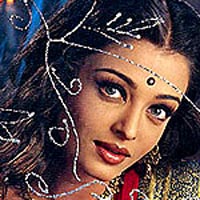

Rekha [above right], who acted in the original, has been described as Bollywood's only real diva, so it's impossible for Ash to top her (Madhuri Dixit could conceivably have done it, but she's currently retired). However the set dressers could certainly go to town on the visual effects, but again, I hesitated. I saw a behind-the-scenes featurette on another Bollywood show and the costumers etc (who were all wearing jeans and t-shirts) said it was hard to recreate Lucknow of 1899. Are they that out of touch with their history? So I nixed the movie but did pick up the soundtrack which has music by Anu Malik and lyrics by Javed Akhtar. The premise of the story is that Umrao, who is kidnapped as a child and raised to be a courtesan, becomes the greatest poet, singer and dancer ever. Even in translation from Urdu, the Sufi poetry she delivers is lovely and quite moving. The original film featured Asha singing and includes the classic "Dil cheez kya hai," in addition to a sublime score by Khaiyaam. The new music is a little watered-down, more "modern" sounding like ersatz traditional music, and recalls the DEVDAS soundtrack to a considerable extent, but that's okay: there's lots of traditional instruments -- flute, that shrill oboe the shehnai, and the woody fiddle known as the sarangi, tinkling ankle bracelets, tablas and swooshing violins. Alka is fantastic: she can twist those high notes just like Asha. I suppose I will break down next year and watch the new version on DVD. By then I might even have a cel-phone loaded with ringtones from the film. Or not.
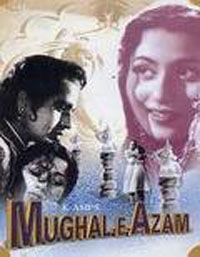
NAUSHAD ALI
MUGHAL-E-AZAM SOUNDTRACK
Naushad Ali died in May 2006 age 86. He was a film composer in Bollywood who had many hits in films like MOTHER INDIA (1957) -- not my favorite Nargis film by any means but musically interesting as it uses folk songs. What I found compelling about his later scores was the way he used classical music motifs lightly. Purists hate this, but I admit to owning a collection of ersatz Arabic music, so pseudo-ragas and bhajans are fine by me. Naushad combined flute and clarinet, sitar with mandolin, and introduced the accordion to Hindi film music. He was first to use a large western orchestra and this has now became a facet of filmi soundtracks. His major hits include songs in Mughal-e-Azam, Mother India ("Zindagi mein hum aaye hei to jeena hi padega") and Kohinoor ("Madhuban mein radhika nache re"). Naushad was among the first composers to give Lata Mangeshkar an opportunity to sing and his Andaaz was one of her breakthrough soundtracks. He was also the first to record music tracks separately and then record the playback singers on a second track. This way he could use background music to extend the mood before and after the song.
After Ted Turner's experiments with colorization, American audiences basically said, No mo' dis shit, and it was dropped, but Hindi film tycoons are more practical. They know young audiences wont see a black and white film and so made a big deal last year about colorizing MUGHAL-E-AZAM (1960), one of their most spectacular films. The version I saw (which was the original) only had colour in the songs, like in CHAUDHVIN KA CHAND or SECRET GARDEN in Hollywood. (I know Secret Garden doesn't have songs, but it has partial colour, OK? Come to think of it, why hasn't Andrew Dice Webber made a musical of it yet? It has everything: crippled boy, hunchback uncle, orphan girl, death and resurrection.)
Mughal-e-Azam is every inch an epic. Salim (Dilip Kumar), the son of Emperor Akbar, falls in love with Anarkali (Madhubala), a courtesan. The film took 14 years to make and the principal actors' story reflects the movie when Dilip Kumar's parents forbade him to date Madhubala! Naushad brought in classical singer Bade Ghulam Ali Khan for this most celebrated score: he performs "Shubh Din Aayo" and "Prem Jogan ke Sundari Pio Chali." Actually it happened by fluke: Khan was stand-offish about stooping to sing in the movies so asked an exorbitant fee. After consideration the producers agreed. Then there's Lata singing "Mohabbat ki Jhooti Kahani pe Roye," a gorgeous song where she bends notes beneath a huge sweeping orchestral score, and "Pyaar Kiya to Darna Kya." Check out the former on Beginners Guide to Bollywood, and the latter on the Rough Guide to Lata. Even Mohammed Rafi shows up for "Ae Mohabbat Zindabad" with a chorus of 100! The lyrics are Urdu poetry. Another success, Baiju Bawra, extended Naushad's dabbling with classical music. He wrote other notable scores for Nitin Bose's gangster flick Ganga Jamuna (1961) and Mere Mehboob (1963).
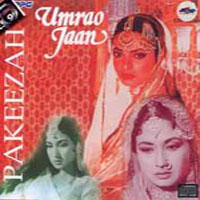
PAKEEZAH & UMRAO JAAN soundtracks
(HMV India CDF120364; do not pay more than 109 rupees)
Naushad Ali completed the music for PAKEEZAH (1972) after Ghulam Mohammed's death. I love this soundtrack, which is also pseudo-classical music, accompanying one of my favourite Bollywood films. It is teamed on CD with another great soundtrack: UMRAO JAAN (1981). The Duchess is not so keen on these two movies which depict the life of courtesans in the splendour of the Raj in the nineteenth century. Yes, the women have tragic lives, basically sold into prostitution as children, but it's easy to suspend credibility and enjoy the spectacle. The gorgeous actresses remain quite pure, and true to their lovers, though hamstrung by fate. For me it's all about the music, the dancing, the sets, the costumes. Nevermind the cartoony villains twirling their moustaches as they plot to deflower the girls, or the harpy heartless madames counting their rupees. Like MUGHAL-E-AZAM, PAKEEZAH took fifteen years to make and during the filming the director broke up with his leading lady, Meena Kumari, who took to drink, and died two months after the premiere. Ghulam Mohammed wrote all the songs apart from the title music, which was left to Naushad. Lata is the featured singer. "Chalte Chalte" is the classic number (I watch it frequently and love the fake moonlit garden backdrop, and the lethargic twirling backing dancers). It's painfully slow: the backbeat just echoes off the back of your cerebellum. It has the most sensuous and forlorn train whistle on record. Too bad it wasn't better recorded.

UMRAO JAAN is a bit more racy as it shows the heroine in bed with her sweetheart. Omar Khayyam wrote the music. That's what it says. Asha is the main playback singer, so here's another chance to compare the two sisters. It opens with the hit "Dil cheez kya hai." Not that I am suggesting you buy the CD until you have seen both films. The director Muzzaffar Ali invited all the Lucknow nobility to be extras in the film, on condition they wore their finest outfits and jewelry! Umrao is schooled in all the arts. Her music teacher instills great Sufi poetry in her so she becomes famous as a writer and performer of ghazals. The poetry of this film (composed by Shahryar) is on another level altogether from most films and an added bonus. I won't mention how hot Rekha the actress is in case the Duchess trepans me with a skillet. Again the CD is marred by fuzzy sound.

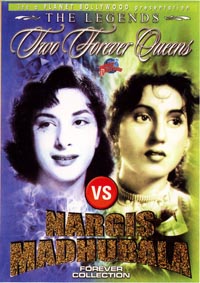
BOLLYWOOD
AN ANTHOLOGY OF SONGS FROM POPULAR INDIAN CINEMA (Silva Screen CD1204)
2005 was a bad year for Bollywood films. The big hits this year were derivative of American films, like Bonnie & Clyde or The Godfather (which I am sure was a bloated piece of garbage, though I never saw it; I read the book and was thoroughly revolted, plus I detest Brando's "acting"). Amitubby's latest is a remake of "Man on Fire" (No, not the Denzel Washington film, that was a remake of a French film!). For the first time in years Shah Rukh Khan didn't make the top film, in fact he didn't cut the critics' top ten film lists. I enjoyed him in Paheli while my Hindustani friends walked out. I also enjoyed Mangal Pandey, a historic tale of the Raj, but then I sported one of those British army redcoats in my Mod days as a youth. This compilation, licensed from Saregama in India, is also derivative. It seems to go on the premise that there has never been a Bollywood hits anthology before, so it starts with two songs that have been anthologized too many times: Geeta Dutt's "Meera naam Chin Chin Chu," and Asha's "Ina Mina Dika." Her "Dum maro dum" and "Churaliya" are also here, showing a real lack of imagination. But there are some overlooked gems in the mix: "Kabhi kahbi mere dil mein khayal aata" sung by Lata and Mukesh perfectly sums up the aching doomed love of Amitabh and Rakhi in the 1976 tragic love story Kabhi Khabi. "Roop tera mastana" is another gem that already appeared on the ROUGH GUIDE TO BOLLYWOOD with two other songs on here. Typical of sloppy compilations, it's a double disc, the implication being you can edit your own set out of the mass. I would quibble with their choice of "Ramaiya vastavaiya" from SHREE 420. Either "Pyar hua iqrar hua" or "Mohabbat hamari" would have worked better. The former is one of the highlights of Indian cinema, a scene comparable to Gene Kelly's "Singin in the Rain," except it includes Nargis in the action. She plays a ghostly double in the latter. Lata's "Ayega ayega aanewala" is a gem but there are, again, arguably better choices from MAHAL, the 1949 breakthrough for the lovely Madhubala. The obvious alternative here is to rent or buy the films, or pick up a cheap video anthology, like TWO FOREVER QUEENS: NARGIS VS MADHUBALA (Planet Bollywood PBGM 025) which I found for $5 -- it has 50 video songs on it. (Don't ask me why they always put "Vs" in the title, implying a contest, but these are a great way to figure out which films to see.)
The second disc kicks off with Lata singing "Didi tera devar deewana." Based on folk tunes, it was the most-played wedding song of the 90s. This busy but catchy piece is followed by the grooving "Ek doosre se karte hai" where you can hear Amitabh Bachchan sing (he is unusual in doing his own singing and has a fine voice). Apparently it was sampled by Lil Kim. The Black-eyed Peas (whoever they are) sampled the next cut, from Asha. I think they have also sampled Amparanoia. Isn't there any originality left in North America? R.D. Burman's swan song, also his most beautiful song, "Ek ladki ko dekha" sung by Kumar Sanu from the film 1942 - a love story, floats by with simple sitar and haunting flute over a dhol and percussion backbeat. The three selections from A.R. Rahman are by no means his best work (the rocking "Rang de" aside). I suspect the compiler had a sentimental attachment to the films they are drawn from, rather than taking them on musical merit. The "Saturday Night Fever" of Hindi film, "Jooma Chumma de de" is here (it was previously included on THE BEGINNERS GUIDE TO BOLLYWOOD along with several other selections here). Unfortunately the recording is seriously over-modulated. There's also a companion book if you are interested in knowing more about this great cinema that eclipsed Hollywood but now, sadly, is coming to resemble it in its decline.

KREEM & GULZAR
PAHELI SOUNDTRACK (SF CD 1/905)
The film that got me hooked on Bollywood was DEVDAS and I have seen it half a dozen times and listened to the soundtrack scores of times. It's hard for anything else to come up to that standard: the producers carefully hired several composers to guarantee a varied collection of hit songs -- and PAHELI is the first thing in four years to come close. It's tough to review this without referring to the film so my first suggestion is for you to see it. (My Indian friends didn't like it as much, in fact they walked out! Maybe living in Silicone Valley has made them jaded.) The desperation of American movies (and high-cost of seeing them) drove me straight to Bollywood and while their plots aren't much better they at least have great sets and wonderful song-and-dance numbers. True escapism without things blowing up! I believe the last musicals made in America, CHICAGO & MOULIN ROUGE, were both hits but I couldn't bear to watch either. There's no need to dwell here on the timidity of American studios and their perpetuation of aging talentless crocks as leading men, or how they can lure someone like Ashwariya Rai with big cash offers and plonk her into a worthless picture. Tom Cruise and Harrison Ford are not Edward G. Robinson and Humphrey Bogart. Hell, they're not even Burt Lancaster and Kirk Douglas. Nicole Kidman is no Rita Hayworth and certainly no Madhuri Dixit. India still has big stars, like Amitabh Bachchan who is so revered there are even three temples dedicated to him! PAHELI may have some similarities to BEWITCHED: it's a lightweight story with a strong supernatural element and hokey special effects, but at least it's value for money, with mouthwatering costumes and sets plus cameos from some big filmi names. The story is lifted from the Arabian Nights, which you have to admit is a cut above the Dukes of Hazzard. A beautiful woman (Rani Mukherjee) marries a money-obsessed accountant (Shah Rukh Khan). He sits up on their wedding night adding up the cost of the wedding. Next morning he tells her he's going on a business trip which might last five years but not to worry, the time will pass quickly and she can enjoy his parents' home and pamper herself till his return. A restless spirit who has caught a glimpse of the bride materializes in the guise of the husband and turns up to enjoy her, fooling the greedy father with gold. Inevitably the real husband returns and there's hell to pay. Unable to distinguish between the identical husbands, the family sets off to see the King for judgment but encounter an old goatherd (Amitabh) who is regal in his judgment. The film is set "in the past" in Rajasthan. The music is based loosely on folk music, that is the instrumentation is simple acoustic instruments, which highlights the singing and the melodies. Kreem himself sings on one track but otherwise the up-and-coming singers Sonu Nigham (who frequently sings for SRK) and Bela Shende perform. The mighty Sukhwinder Singh appears on a couple of cuts. It's a perfect escapist fantasy and the soundtrack album lets you stay hidden for a little longer. The final track is an instrumental remix of the opening song so it begs you to start it over.
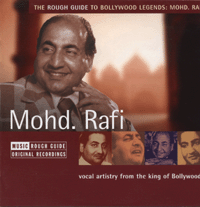
MOHAMMED RAFI
ROUGH GUIDE TO MOHD RAFI (RGNET 1133CD)
After doing a reasonable job with Asha Bhosle, Rough Guide stumbled and fumbled their Lata Mangeshkar and Mohd Rafi compilations. Both of these filmi playback singers deserve a wider swath of their work to be considered for such a condensation. It is well known that playback singers record thousands of songs and many of them are very context specific: if you see the film you are likely to associate actors and actions with the songs and therefore they will have a lot more meaning than if you just hear them in the air. Mohammad Rafi's voice stood in for lots of actors, including Dilip Kumar, Guru Dutt & Amitabh Bachchan. This compilation barely scratches the surface of his work and, like the Rough Guide to Lata, gives you the feeling he only did one or two things instead of a whole range from folksongs to ghazals to devotional singing.
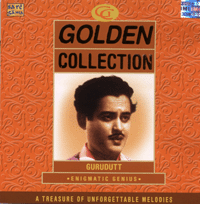
MOHAMMED RAFI & HEMANT KUMAR
GURU DUTT: THE GOLDEN COLLECTION (Saregama CD136034)
I picked up the Golden Collection of Guru Dutt, subtitled "Enigmatic Genius," one of my favourite Bollywood film-makers. He was a bit like Orson Welles: he had a grand & unique vision and stuck to it, using the same cast and crew, but after a commercial flop retired from directing and only appeared as an (occasionally hangdog) actor or writer. He often had Mohammed Rafi sing his part, but also Hemant Kumar, if Rafi was dubbing another actor in the same film. If you are into classic black and white films with great character actors and preposterous plots, you'll want to see his work. The Golden Collection CD is a greatest hits from his films, also featuring his wife Geeta Dutt (who started out as Geeta Ray, a playback singer) and the singing sisters Asha and Lata. This is a well-arranged set, covering all his great films: Pyaasa (which reminds me of some of my self-pitying drunken poet friends), Mr & Mrs 55, C.I.D., Aar Paar, Chaudvin ka Chand (which has one song in ravishing colour dropped into the moody black and white), and others. Guru Dutt died young but left a great legacy in film. The Golden Collection is a fine tribute to him.
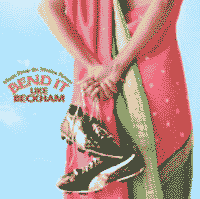
VARIOUS ARTISTS
BEND IT LIKE BECKHAM (Universal, Budget priced)
Check out BEND IT LIKE BECKHAM, a thoroughly entertaining British film. It has a great soundtrack, featuring some slamming Bhangra. However the masala quotient is high in the mix, so it contains lots of other stuff. It's been a while since I had Blondie blasting over my sound system! But not for long, we go from disco (a song by Posh Spice, or "Mrs Beckham") to rap to R&B (Curtis Mayfield's "Move on up") to snippets of dialogue to Italian opera ("Nessun dorma"). Fortunately I can edit the tracks I like onto my iTunes database. Bally Sagoo's tracks stand out. He himself is not held in high repute in India (according to my Indian students) as he is a mere mixologist, but beating the dhol drums will perk you up and make you forget about all the horrible things going on in the real world.

A. R. RAHMAN
SAATHIYA SOUNDTRACK (Jashraj Films)
My Indian film & music explorations continue, prodded by the Duchess, as we find ourselves once more lost in the wilds of Fremont, California, eating chaat served by the surliest waitress in the state, en route to the NAZ cinema and a random pick from the evening's showings on 6 screens. SAATHIYA ("Friends") won the toss because of a soundtrack by A.R. Rahman and the appearance of heart-throb Shah Rukh Khan on the poster. The whole first half (two hours) is taken up with a truly sappy love story. Khan doesn't appear till the end when the film takes an unexpected twist into brutal realism with a car accident that leaves the heroine in a coma. Khan gets to weep on cue, something he does wonderfully. The soundtrack is superb though and won several awards, but then the film even won an award for promoting Swiss tourism, something that happens with increasing frequency in dream sequences in Indian films (Their own snow-capped mountains are rife with terrorism). The mark of success is a dance sequence spanning three continents. Bits of Michael Jackson's THRILLER merge with some familiar Rahman riffs in an altogether pleasant way.
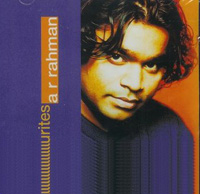
A.R. RAHMAN
FAVOURITES (Sony Music 5 13328 9)
What could be worse than having a resumé that says your favourite musical artists are Zamfir and the Carpenters? Maybe having your greatest ambition -- to perform with Michael Jackson -- be realised? Maybe being asked to collaborate with Andrew Lloyd Weber? Well, as a child of the seventies (Rahman was born Jan 6, 1966 and started playing piano professionally at age 11), Rahman grew up in a bad musical era but has made the most of it. I was fortunate to miss the disco era of the seventies, as I was into Brian Eno and the experimental stuff that was going on at the time. (When I got to Einsturzenden Neubauten I knew I was lost & went to Africa.) But the worst of the 70s keeps coming back to bite us on the buttocks when we are trying to boogaloo. Rahman is still a youngster, and from South India, so he didn't grow up with the options many of us had. Imported music was all Beatles and Beegees but he was also exposed to Carnatic music and, after his conversion to Islam, Sufi music. He is so prolific, it's impossible to keep up with him. Though he is Tamil, he writes music for Hindi films as well. His biggest hit was the soundtrack to the film BOMBAY (on which he appears as a playback singer for the first time). He was the first Indian artist signed by Sony in 1997 and one of his albums for them, VANDE MATARAM, written to celebrate India's 50th anniversary as an independent country, was a monster seller. His later scores include DIL SE (Warning: avoid this film at all costs!!) and TAAL, to name but two.
I have several Rahman BEST OF compilations. FAVOURITES starts out right with three blockbusters in a row. "Ghanan Ghanan" was in the film LAGAAN which I thought was above average but not Oscar-worthy (unlike DEVDAS which wasn't even nominated). I don't remember the dance number, probably villagers in spotless clothes waving their arms on a hillside. I do recognise the playback singers though. It has a good and insistent drum part which gives it momentum. Next up the train song from DIL SE -- more juggernaut momentum, this time dancers on top of a train (in more spotless clothes!) waving their arms in unison. No one falls off (at least on camera). Things move up a notch as the tempo increases for "Rang De" from the action film TAKSHAK, sung by Asha Bhosle. Despite the wet flute solo it cooks along. "Dola Re" from DIL HI DIL MEAIN (not to be confused with "Dola re Dola" from DEVDAS) is another catchy tune well-known from the Bollywood Brass version on RAHMANIA! The opening of "So gaye hain" with cor anglais and strings sounds like Petula Clark is about to burst forth, but it's Asha (no surprise) in the first of two selections from ZUBEIDAA. Then we are treated to "Kahin Aag Lage" from TAAL, overall one of Rahman's best scores. His biggest hit before "Vande Mataram" was the score to BOMBAY and the theme is here to round things out. However it's one you need to see, as the music on its own is rather sentimental. This is a great collection and bound to lead you further into the work of one of the world's top pop composers.
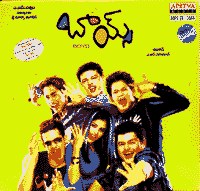
A.R. RAHMAN
BOYS (AMIL CD 5508)
BOYS sounds like one to miss. In fact Rahman stopped work on it when he heard it involved teenage boys looking at internet porn and doing other naughty things boys do. Muslims don't do that, so Rahman gave them the songs he'd done and bowed out. There are a couple of sure-fire hits on here, despite the fact they are sung in English. Rahman is the master of the catchy riff. This one is disco and wanky synth all the way, but there are times when that's what you need (like when you are vacuuming the rug!). It kicks off with a funny sample, Liberace saying "And now it's time to return to the classics..." What's bizarre is that Malkit Singh uses the same sample on his albums. I only know it because we had a cart of it at the radio station and used to drop it between songs as a joke. There's some heavy metal nonsense ("Walk this way" is probably the source) that kicks in by the second track. If you can stomach that then the vocoder on the vocals is easy to swallow. The real drawback though is the English lyrics. I don't mind listening to songs in Tamil or Hindi, only really noticing the language difference when Asha pours her heart into the expression "Dil cheez...", but when you get the full thrust of the lyrics in the title song. "D-a-t-i-n-g: you and me were meant to be; yeah, I can clearly see: Dating is a fantasy," it's pukeworthy. So why get this CD? First it's only about $4! and second the fourth track is truly catchy. The fifth track reminds me of early Bowie, but it goes downhill to an Alice Cooper-like track called "Break the rules." One for Rahman diehards only!
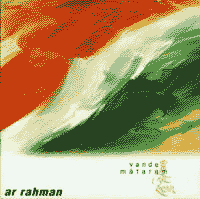
A.R. RAHMAN
VANDE MATARAM (Sony Music 488709-2 1997)
HUMMA HUMMA (T Series/Super Cassettes Industries India SVCD 1629)
The title cut from VANDE MATARAM starts portentiously with booming bass drum and droning synths while a half-whispered chorus states the title over and over. It reminds me a lot of "Biko" by Peter Gabriel, undoubtedly another influence on young Allah. The VANDE MATARAM album, which is an all-time best-seller in India, was recorded in England and features Nusrat and a bunch of British session guys. It's Rahman's most Gabriel-like album & I am surprised it didn't come out on RealWorld as it seems the quintessential world fusion recording. I recommend it, particularly as a change from the non-stop dance fever of most of his soundtracks.
HUMMA HUMMA is in fact another greatest hits collection of Rahman songs. The songs are well-sequenced and though there's a flat spot toward the end, it starts strong and comes back at the finish. There are hits from RANGEELA, JEANS, ROJA, 1947 EARTH, and other films, plus some pleasant surprises. The first track, "Humma Humma" is a must-see from the film BOMBAY, as it not only sounds like Michael Jackson but the dancers are equally as good. It's a serious film where the goofy dance numbers give a respite from the religious strife and tragedy! The instrumentation is novel and shows how Rahman can fit together classical sounds with breakbeat rhythms. "Ooh la la la," from SAPNAY is new to me, but a Rahman classic, as is the other selection from the same film, "Awara Bhanwre," sung by Mano and Sujatha. It's has a play-along catchiness to it, and if it's not C, F & G, my name ain't Sloopy! After a couple of tracks that are exceedingly ponderous and, well, cinematic, things perk up with "Banno Rani" from 1947 EARTH, sung by perky Sadhna Sargam. A tune I love from the Bollywood Brass version, "Urvashi Urvashi," rounds the album out and the sung version makes a great contrast to the brass version.
